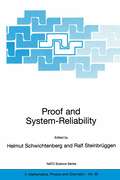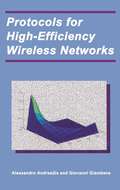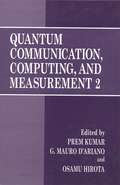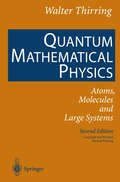- Table View
- List View
Programming Languages and Systems: 11th European Symposium on Programming, ESOP 2002, Held as Part of the Joint European Conferences on Theory and Practice of Software, ETAPS 2002 Grenoble, France, April 8-12, 2002. Proceedings (Lecture Notes in Computer Science #2305)
by Daniel Le MetayerETAPS2002wasthe?fthinstanceoftheEuropeanJointConferencesonTheory and Practice of Software. ETAPS is an annual federated conference that was established in 1998 by combining a number of existing and new conferences. This year it comprised 5 conferences (FOSSACS, FASE, ESOP, CC, TACAS), 13 satellite workshops (ACL2, AGT, CMCS, COCV, DCC, INT, LDTA, SC, SFEDL, SLAP, SPIN, TPTS, and VISS), 8 invited lectures (not including those speci?c to the satellite events), and several tutorials. The events that comprise ETAPS address various aspects of the system - velopmentprocess,includingspeci?cation,design,implementation,analysis,and improvement. The languages, methodologies, and tools which support these - tivities are all well within its scope. Di?erent blends of theory and practice are represented, with an inclination towards theory with a practical motivation on one hand and soundly-based practice on the other. Many of the issues involved in software design apply to systems in general, including hardware systems, and the emphasis on software is not intended to be exclusive.
Programming Languages and Systems in Computational Economics and Finance (Advances in Computational Economics #18)
by Soren Bo NielsenThe developments within the computationally and numerically oriented ar eas of Operations Research, Finance, Statistics and Economics have been sig nificant over the past few decades. Each area has been developing its own computer systems and languages that suit its needs, but there is relatively little cross-fertilization among them yet. This volume contains a collection of papers that each highlights a particular system, language, model or paradigm from one of the computational disciplines, aimed at researchers and practitioners from the other fields. The 15 papers cover a number of relevant topics: Models and Modelling in Operations Research and Economics, novel High-level and Object-Oriented approaches to programming, through advanced uses of Maple and MATLAB, and applications and solution of Differential Equations in Finance. It is hoped that the material in this volume will whet the reader's appetite for discovering and exploring new approaches to old problems, and in the longer run facilitate cross-fertilization among the fields. We would like to thank the contributing authors, the reviewers, the publisher, and last, but not least, Jesper Saxtorph, Anders Nielsen, and Thomas Stidsen for invaluable technical assistance.
Programming the Network with Perl
by Paul BarryAfter providing an introduction to the Perl programming language, this helpful guide teaches computer networking using Perl. Topics discussed include ethernet network analysis, programming standard Internet protocols, and exploring mobile agent programming. * Each chapter provides a general discussion of the technologies under consideration, the support for programming the technologies as provided by Perl, and implementations of working examples * Covers Mobile Agent Technology, which is set to become one of the "next big things" on the Internet * Further information is supplied, including a listing of Web and print resources, programming exercises, and tips to expand the reader's understanding of the material
Programming the Web with Visual Basic .NET
by Constance Petersen Lynn TorkelsonAfter reading Programming the Web with Visual Basic .NET, developers will understand how to build and deploy top quality, professionally designed, highly usable Web applications using Visual Basic .NET.
Programming VB .NET: A Guide For Experienced Programmers
by Jonathan Morrison Gary CornellIn Programming VB .NET: A Guide for Experienced Programmers, authors Gary Cornell and Jonathan Morrison carefully explain the exciting features of Visual Basic .NET. Since VB .NET is, for all practical purposes, a whole new language even for the most experienced Visual Basic programmers, developers need to think differently about many familiar topics. Cornell and Morrison are there to help you with careful discussions of each topic. Cornell and Morrison write from the point of view of the experienced programmer, with constant references to the changes from earlier versions of VB. Developers learn how to use VB .NET for database programming through ADO.NET and web programming through ASP.NET. After reading Programming VB .NET: A Guide for Experienced Programmers, developers will have a firm grasp of the exciting VB .NET language and its uses in creating powerful .NET applications.
Progress in Cryptology - INDOCRYPT 2002: Third International Conference on Cryptology in India Hyderabad, India, December 16-18, 2002 (Lecture Notes in Computer Science #2551)
by Alfred Menezes Palash SarkarThe third successful completion of the INDOCRYPT conference series marks the acceptance of the series by the international research community as a forum for presenting high-quality research.It also marks the coming of age of cryptology research in India. The authors for the submitted papers were spread across 21 countries and 4 continents, which goes a long way to demonstrate the international interest and visibility of INDOCRYPT.In the previous two conferences, the submissions from India originated from only two institutes; this increased to six for the 2002 conference.Thus INDOCRYPT is well set on the path to achieving two main ob jectives – to provide an international platform for presenting high-quality research and to stimulate cryptology research in India. The opportunity to serve as a program co-chair for the third INDOCRYPT carries a special satisfaction for the second editor.Way back in 1998, the sci- ti?c analysis group of DRDO organized a National Seminar on Cryptology and abbreviated it as NSCR.On attending the seminar, the second editor suggested that the conference name be changed to INDOCRYPT.It is nice to see that this suggestion was taken up, giving us the annual INDOCRYPT conference - ries.Of course, the form, character, and execution of the conference series was the combined e?ort of the entire Indian cryptographic community under the dynamic leadership of Bimal Roy.
Progress in Discovery Science: Final Report of the Japanese Discovery Science Project (Lecture Notes in Computer Science #2281)
by Setsuo Arikawa Ayumi ShinoharaProgress in Industrial Mathematics at ECMI 2000 (Mathematics in Industry #1)
by Angelo M. Anile Vincenzo Capasso Antonio GrecoRealizing the need of interaction between universities and research groups in industry, the European Consortium for Mathematics in Industry (ECMI) was founded in 1986 by mathematicians from ten European universities. Since then it has been continuously extending and now it involves about all Euro pean countries. The aims of ECMI are • To promote the use of mathematical models in industry. • To educate industrial mathematicians to meet the growing demand for such experts. • To operate on a European Scale. Mathematics, as the language of the sciences, has always played an im portant role in technology, and now is applied also to a variety of problems in commerce and the environment. European industry is increasingly becoming dependent on high technology and the need for mathematical expertise in both research and development can only grow. These new demands on mathematics have stimulated academic interest in Industrial Mathematics and many mathematical groups world-wide are committed to interaction with industry as part of their research activities. ECMI was founded with the intention of offering its collective knowledge and expertise to European Industry. The experience of ECMI members is that similar technical problems are encountered by different companies in different countries. It is also true that the same mathematical expertise may often be used in differing industrial applications.
Project Management for the 21st Century
by Bennet Lientz Kathryn ReaThe challenge of managing projects is to combine the technology of the future with lessons from the past. In the Third Edition of Project Management for the 21st Century, noted authors Bennet Lientz and Kathryn Rea provide a modern, proven approach to project management. Properly applied without massive administrative overhead, project management can supply structure, focus, and control to drive work to success.Third Edition revisions include: 35% new material; three new chapters on risk management, international and multinational projects, project culture; entire text rewritten to take advantage of the Web and Internet tools; new appendix covering web sites; additional materials on "what to do next"; more feedback from readers and lessons learned.
Project Management for the 21st Century
by Bennet Lientz Kathryn ReaThe challenge of managing projects is to combine the technology of the future with lessons from the past. In the Third Edition of Project Management for the 21st Century, noted authors Bennet Lientz and Kathryn Rea provide a modern, proven approach to project management. Properly applied without massive administrative overhead, project management can supply structure, focus, and control to drive work to success.Third Edition revisions include: 35% new material; three new chapters on risk management, international and multinational projects, project culture; entire text rewritten to take advantage of the Web and Internet tools; new appendix covering web sites; additional materials on "what to do next"; more feedback from readers and lessons learned.
Project Scheduling with Time Windows: From Theory to Applications (Contributions to Management Science)
by Ulrich DorndorfProject Scheduling is concerned with the allocation of scarce resources over time. The rich optimisation models with time windows that are treated in this book cover a multitude of practical decision problems arising in diverse application areas such as construction engineering or make-to-order production planning.The book shows how Constraint Propagation techniques from Artificial Intelligence can be successfully combined with Operations Research methods for developing powerful exact and heuristic solution algorithms for a very general class of scheduling problems. Example applications demonstrate the effectiveness of the approach.
Proof and System-Reliability (NATO Science Series II: Mathematics, Physics and Chemistry #62)
by Helmut Schwichtenberg Ralf SteinbrüggenAs society comes to rely increasingly on software for its welfare and prosperity there is an urgent need to create systems in which it can trust. Experience has shown that confidence can only come from a more profound understanding of the issues, which in turn can come only if it is based on logically sound foundations. This volume contains contributions from leading researchers in the critical disciplines of computing and information science, mathematics, logic, and complexity. All contributions are self-contained, aiming at comprehensibility as well as comprehensiveness. The volume also contains introductory hints to technical issues, concise surveys, introductions, and various fresh results and new perspectives.
Protocols and Systems for Interactive Distributed Multimedia: Joint International Workshops on Interactive Distributed Multimedia Systems and Protocols for Multimedia Systems, IDMS/PROMS 2002, Coimbra, Portugal, November 26-29, 2002, Proceedings (Lecture Notes in Computer Science #2515)
by Fernando Boavida Edmundo Heitor Da Silva Monteiro Joao OrvalhoProtocols for High-Efficiency Wireless Networks
by Alessandro Andreadis Giovanni GiambeneThis invaluable reference book focuses on the air interface of mobile networks at different layers according to the OSI Reference Model. It provides an overview of several wireless communication systems as well as mobile satellite systems, followed by detailed analysis of radio resource management issues.
Protocols for High Speed Networks: 7th IFIP/IEEE International Workshop, PfHSN 2002, Berlin, Germany, April 22-24, 2002. Proceedings (Lecture Notes in Computer Science #2334)
by Georg Carle Martina ZitterbartThis workshop on “Protocols for High-Speed Networks” is the seventh in a s- cessful series of international workshops, well known for their small and focused target audience, that provide a sound basis for intensive discussions of hi- qualityand timelyresearch work. The location of the workshop has alternated between Europe and the United States, at venues not onlyworth visiting for the workshop, but also for the distinct impressions theyleave on the participants. The ?rst workshop was held in 1989 in Zurich. Subsequentlythe workshop was moved to Palo Alto (1990), Stockholm (1993), Vancouver (1994), Sophia-Antipolis/Nice (1996), and Salem (1999). In 2002, the workshop was hosted in Berlin, the capital of Germany. PfHSN is a workshop providing an international forum that focuses on issues related to high-speed networking, such as protocols, implementation techniques, router design, network processors and the like. Although the topics have shifted during the last couple of years, for example, from parallel protocol implemen- tions to network processors, it could be observed that high speed remains a very important issue with respect to future networking. Traditionally, PfHSN is a r- ativelyfocused and small workshop with an audience of about 60 participants.
Prozeßmanagement: Modelle und Methoden
by Günter SchmidtDieses Buch führt in grundlegende Modelle und Methoden für die Planung, Steuerung und Überwachung von Unternehmensprozessen ein. Im Mittelpunkt der Diskussion steht die Analyse der Abläufe mit dem Ziel der Optimierung. Besondere Aufmerksamkeit wird in der neuen Auflage analytischen und wissensbasierten Verfahren gewidmet. Zu diesem Zweck werden sowohl verschiedene Modelle entworfen als auch entsprechende Methoden zur Problemlösung vorgestellt. Dabei werden die Entwurfs- und die Realisierungsebene von Prozessen unterschieden und einer eingehenden Betrachtung unterzogen. Den Rahmen der Ausführungen bilden die Aufgaben des dispositiven Prozeßmanagements.
Prozessmodellierung mit ARIS®: Eine beispielorientierte Einführung für Studium und Praxis
by Heinrich SeidlmeierDas ARIS Toolset der IDS Scheer AG ist das weltweit führende Prozessmodellierungstool. Dem Leser dieses Buches wird der Einstieg in das Konzept und in das Softwarewerkzeug erleichtert, entweder als Ergänzung bzw. Fortführung zu einer besuchten Schulung oder auch im Selbststudium. Es wird kompakt das notwendige Know-how zur Durchführung einfacher Projekte vermittelt: Prozessgrundwissen, ARIS-Bedienung und Systemverwaltung, Modelle und Modellierung sowie Modellauswertungen. Aufgaben mit Lösungen und eine umfangreiche Fallstudie bieten ausreichend Übungsmöglichkeiten. Praktische und konkrete Anwendungen in den Bereichen Dokumenten- und Workflowmanagementsysteme machen das Buch insbesondere auch für erfahrene ARIS-Anwender interessant.
Public Key Cryptography: 5th International Workshop on Practice and Theory in Public Key Cryptosystems, PKC 2002, Paris, France, February 12–14, 2002 Proceedings (Lecture Notes in Computer Science #2274)
by Pascal Paillier David NaccachePublic Key Cryptography - PKC 2003: 6th International Workshop on Theory and Practice in Public Key Cryptography, Miami, FL, USA, January 6-8, 2003, Proceedings (Lecture Notes in Computer Science #2567)
by Yvo DesmedtThis book constitutes the refereed proceedings of the 6th International Workshop on Practice and Theory in Public Key Cryptosystems, PKC 2003, held in Miami, Florida, USA in January 2003. The 26 revised full papers presented were carefully reviewed and selected from 105 submissions. The papers are organized in topical sections on Diffie-Hellman based schemes, threshold cryptography, reduction proofs, broadcast and tracing, digital signatures, specialized multiparty cryptography, cryptanalysis, elliptic curves: implementation attacks, implementation and hardware issues, new public key schemes, and elliptic curves: general issues.
The qmail Handbook
by Dave SillThe qmail Handbook is designed to guide system and mail administrators of all skill levels through the installation, configuration, and maintenance of the qmail server. Author Dave Sill, a longtime qmail user, system administrator, and technical support agent (as well as the author of the popular online tutorial "Life with qmail”), provides you with the practical tools to work with this popular mail server. Sill begins with a discussion of qmails architecture and features, and then delves into a thorough investigation of the installation and configuration processes. You'll learn how to install qmail on several operating systems, and gain valuable insight into proper configuartion, testing procedures, and performance tuning. You'll also learn how to administer users and mail, install filters, and oversee daily qmail operation and maintenance. Throughout, Sill focuses on topics essential to all mail administrators, elaborating on such subjects as configuring mailing list managers, controlling spam, secure networking, scanning for viruses, hosting virtual domains and users, and creating dial-up clients.
Qualitative Spatial Reasoning with Topological Information (Lecture Notes in Computer Science #2293)
by Jochen RenzSpatial knowledge representation and reasoning with spatial knowledge are relevant issues for many application areas such as robotics, geographical information systems, and computer vision. Exceeding purely quantitative approaches, more recently initiated qualitative approaches allow for dealing with spatial information on a more abstract level that is closer to the way humans think and speak.Starting out with the qualitative, topological constraint calculus RCC8 proposed by Randell, Cui, and Cohn, this work presents answers to a variety of open questions regarding RCC8. The open issues concerning computational properties are solved by exploiting a broad variety of results and methods from logic and theoretical computer science. Questions concerning practical performance are addressed by large-scale empirical computational experiments. The most impressive result is probably the complete classification of computational properties for all fragments of RCC8.
Quality-Driven Query Answering for Integrated Information Systems (Lecture Notes in Computer Science #2261)
by Felix NaumannThe Internet and the World Wide Web (WWW) are becoming more and more important in our highly interconnected world as more and more data and information is made available for online access. Many individuals and governmental, commercial, cultural, and scientific organizations increasingly depend on information sources that can be accessed and queried over the Web. For example, accessing flight schedules or retrieving stock information has become common practice in todays world. When accessing this data, many people assume that the information accessed is accurate and that the data source can be accessed reliably. These two examples clearly demonstrate that not only the information content is important, the information about the quality of the data becomes an even more crucial and critical aspect for individuals and organizations when they make plans or take decisions based on the results of their queries. More precisely, having access to information of known quality becomes critical for the well-being and indeed for the functioning of modern industrialized societies. Surprisingly, despite the urgent need for clear concepts and techniques to judge and value quality and for technology to use such (meta) information, very few scientific results are known and available. Few approaches are known to use quality measures for accessing and querying information over the Web. Only a limited number of products on the IT market address this burning problem.
Quantum Calculus (Universitext)
by Victor Kac Pokman CheungSimply put, quantum calculus is ordinary calculus without taking limits. This undergraduate text develops two types of quantum calculi, the q-calculus and the h-calculus. As this book develops quantum calculus along the lines of traditional calculus, the reader discovers, with a remarkable inevitability, many important notions and results of classical mathematics. This book is written at the level of a first course in calculus and linear algebra and is aimed at undergraduate and beginning graduate students in mathematics, computer science, and physics. It is based on lectures and seminars given by MIT Professor Kac over the last few years at MIT.
Quantum Communication, Computing, and Measurement 2
by Prem Kumar Osamu Hirota G. Mauro D'ArianoBased on the Fourth International Conference on Quantum Communication, Measurement and Computing, this volume brings together scientists working in the interdisciplinary fields of quantum communication science and technology. Topics include quantum information theory, quantum computing, stochastic processes and filtering, and quantum measurement theory
Quantum Mathematical Physics: Atoms, Molecules and Large Systems
by Walter ThirringThis book is a new edition of Volumes 3 and 4 of Walter Thirring’s famous textbook on mathematical physics. The first part is devoted to quantum mechanics and especially to its applications to scattering theory, atoms and molecules. The second part deals with quantum statistical mechanics examining fundamental concepts like entropy, ergodicity and thermodynamic functions.























